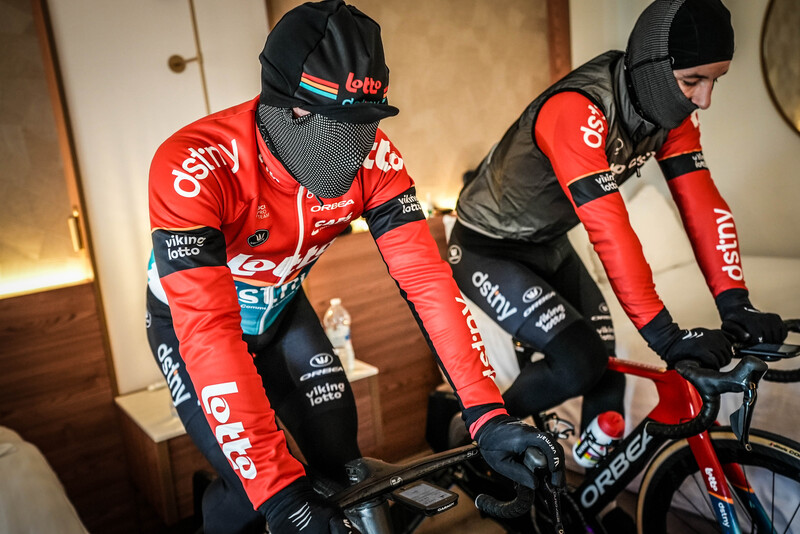Athletes often use heat training to help prepare for a race in the heat. It’s a strategy that’s pretty easy to justify from a common sense perspective, not to mention the historical research and real-world examples that support this practice.
Recently though, a growing body of literature has been looking at whether heat training can give athletes performance gains in all conditions, not only when competing in hot weather…
Heat training: why do it?
Some key physiological adaptations associated with heat training include:
- Increased blood plasma volume
- Increased stroke volume and cardiac output
- Reduced resting and exercising heart rate and core body temp
- Increased maximal sweat rate and (skin blood flow)
- Earlier onset of sweating and increased sweating efficiency (better sweat coverage over the body)
- Decreased heat strain and heat illness risk
When Andy chatted to the Lotto Dstny team at their training camp, they said they incorporate heat training to increase blood plasma volume, increase haemoglobin mass and improve sweating responses. This is consistent with the adaptations we see in the literature when trained individuals undergo a specific heat protocol.
While these benefits from heat acclimation appear to last for 1-2 weeks, the speed at which they decline (decay) varies depending on several factors, including fitness level, environmental conditions, intensity and duration of training.
Interestingly, there’s a potential difference between the sexes. Although the overall impact of the training appears similar, research suggests that women may require more sessions or greater total thermal stress to reap the same benefits. Furthermore, untrained individuals may see an increased response to heat training more positively due to their increased room to grow compared to trained individuals.
Interestingly, there’s a potential difference between sexes. Although the overall impact of the training appears similar, research suggests that females may require more sessions or greater total thermal stress to reap the same benefits. Furthermore, untrained individuals may improve their maximal aerobic capacity faster than trained individuals.
Whilst the evidence overwhelmingly points to heat training significantly improving your performance in the heat, the case for enhancing your performance in cooler conditions isn’t quite so clear cut. That’s largely due to current studies using differing training status, conditions and durations of interventions.
A meta-analysis suggested it falls into the ‘marginal gains’ category; so heat acclimation can “enhance VO2 max adaptation in thermoneutral or hot environments, by at least a small and up to a moderate-large amount, with the larger improvements occurring in the heat.”
Heat training vs. altitude training
What the latest research is showing, is that the right type of heat training might actually be a similar but more practical alternative to altitude training for many athletes.
Logistically, it’s not an easy task to hit the optimal altitude and also be close enough to a lower altitude where you can do your high intensity training at a high quality. Compare that to heat training where you can throw on a few extra layers of clothes or jump in the lab, get sweating quickly and, importantly, leave that stressful environment when training is finished.
One benefit of altitude training is increased red blood cell mass with downstream effects on V̇O₂ max. In a study of trained cyclists, who underwent 10 days of heat training, they showed a 6.5% increase in plasma volume and a 5% increase in stroke volume and V̇O₂ max.
The authors compare that to altitude training, which typically elicits a 1.1% increase in haemoglobin mass for each 100 hours spent at >2100m (until ~500 hours or 3 weeks, when the linear adaptation tails off), and a 0.6-0.7% increase in V̇O₂ max for each 1% increase in haemoglobin mass. After 10 days (240 hours), this would be a 2.64% increase in Hb mass, and roughly 1.7% change in V̇O₂ max
Outside of the lab, cyclists are putting this heat principle into practice. Dr. Jan Boone is a professor in exercise physiology at the University of Ghent and works as part of Lotto Dstny’s performance team to help maximise athletic conditioning.
Jan explains, “our body transports oxygen to our muscles and the more oxygen we can use the better for performance. So that's actually quantified in the parameters V̇O₂ max.” He goes on to say that their goal with heat training, “similarly to altitude training, we try to improve the capabilities of the body to transport oxygen by increasing haemoglobin in the blood.”
But don’t immediately combine heat and altitude training for the best of both worlds. A recent study investigated this idea and didn’t find any significant benefit of the combination compared to one of the training approaches in isolation. The trouble with heat and altitude is the level of stress placed on the body. At this point there’s no evidence to suggest any benefit of combining the two. So hold fire for now.
How to approach heat training
In research, very specific protocols for heat training are used in an attempt to control as many variables as possible and accurately gauge the response. As Dr. Boone explains:
There are a few studies on how to apply heat training, and we can do it in really standardised conditions by using a climate chamber. We set the temperature and the humidity to specific degrees, so that we apply the thermal stress to the body. Of course, that’s not always easily accessible and easy to do for everyone.
The ‘scientific’ standard of practice outlined in this paper recommends:
- Exercising for 90+ minutes at an intensity that elicits a core body temperature of ≥38.5°C (101.3°F). (For example: fixed workload at 70-80% HRmax with ambient conditions of 35°C–40°C (95°F-104°F) and 30%–70% relative humidity)
- While the benefit can be seen rapidly (three or four sessions), following the protocol for 10-14 consecutive days is advised for more significant differences
- As an athlete progresses through the training, the intensity or duration of the exposure should increase to make sure that the same thermal strain is being imposed
As Dr. Boone pointed out, most people – even a high performing cycling team like Lotto – need a more practical approach.
“The important thing is that we increase core temperature. So we have to increase core temperature to a certain degree, your body is triggered to lose heat and then the adaptations can occur.”
Wear and where
If you’re not living in a year-round hot climate, the most practical way to heat train is to put on a lot of extra clothes. Bundle up. Victor Campenaerts’ go-to outfit is “leg warmers, socks, gloves, full head covering, base layer, garbage bag, another thick long sleeve layer, rain jacket, body and thermal jacket.”

I’m getting claustrophobic just thinking about having all those layers on. An alternative option is wearing a few less clothes and sticking yourself in a hot garage with heaters.
What and when
Dr. Boone recommends five sessions per week for five weeks, in keeping with the scientific literature, though the benefit may certainly be observed faster than that.
Notably, the intensity of those sessions should be kept in an appropriate range so as not to interfere with the remainder of the athlete’s normal training. Instead of concrete limitations, setting guidelines is advised, especially when you factor in the possible need to increase absolute intensity to maintain the relative intensity needed for consistent thermal stress as noted above.
“It's important that those sessions are hard but they cannot be excessive in training load. The power output that they produce is around 50% of their functional threshold power and we give the indication that their session’s rating of perceived exertion should be somewhere between 11-14 on a 6-20 scale. Fairly light, but somewhat hard, but not really hard. We don’t set limitations but we set as a guideline, 70-80% of maximal heart rate.”
There are additional methods that might accomplish heat training without the ‘training’ part. These passive strategies include hot water immersion, sauna and steam room with the goal of raising core temperature to 38.5°C (101.3°F) for at least 30 minutes immediately after exercise.
Recovery
At Lotto Dstny, their protocol is to drink during the session, measure body weight before and after, and then rehydrate with 150% of the fluid they lost. They follow the current consensus that if a rider’s body weight decreases by more than 2%, they’re at risk of dehydration-related issues.
They’ve also tested their riders’ sweat sodium concentration, so they can individualise electrolyte intakes when replenishing fluids.
Even if they’re taking on carbohydrates during the session, they still need to refuel after with additional carbs. The recovery protocol for endurance athletes restocking glycogen stores is to aim for 1.2g/kg each hour for the first 4 hours after the workout.
Victor said it best: “Recover in the right way with the right amount of salt and carbs.”
Safety
Before you start heat training, it's worth speaking to your coach and seeking the advice of a heat acclimation expert.
It’s also worth being aware of your body’s signs during heat training to ensure you don’t overdo it. This could include things like extreme dizziness, nausea, vomiting, rash, hives, headache and loss of postural control. If you do experience heat exhaustion, try elevating your legs to promote venous return.
Remember…
- The first heat training session will be tough, and while you don’t get used to it completely, it does get easier fairly quickly (usually within the first 3-5 sessions)
- Using a different modality of exercise can still induce the adaptations (i.e. heat training during cycling can still help your running)
- And don’t be surprised if you notice ‘cardiovascular drift’ – when your cardiac output goes up as your blood volume decreases and your need to offload heat increases. This will likely improve as you become more heat acclimated
Heat training checklist
And here are 10 important factors to consider if you’re thinking about starting heat training:
- Don’t heat train alone at first - seek advice from your coach and a heat expert
- START hydrated by preloading with a strong electrolyte drink
- Consider using pre-cooling techniques
- Add layers
- Consider using a device like a Core Body Sensor to monitor your core body temperature (remember, you're aiming for around 38.5°C / 101.3°F)
- Have plenty of fluids to hand (ideally electrolyte drinks)
- Fuel with sufficient carbohydrates per hour
- Measure your sweat rate to understand your sweat losses and hydration needs in the conditions
- Rehydrate by replacing 150% of your fluid losses in the first couple of hours after the session
- Re-fuel after sessions (ideally with 1.2g of carb per kilogram of bodyweight each four for the first four hours after the session)
TL;DR
While it’s pretty clear that heat training can be good for the heat (shocker), it’s less consistent in its benefits for cooler temperatures. If you have a race in hot weather coming up, then heat training is probably a good idea.
Heat training for overall gains in all conditions is more of a (to coin a well-worn phrase)‘marginal gain’ for recreational athletes. It’s something you could consider if you have the time to dedicate 4-5 sessions a week to it, but the priority should be getting the basics of your training right first.
